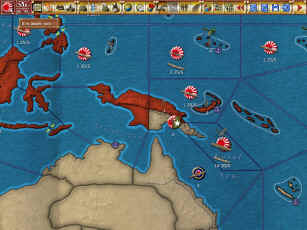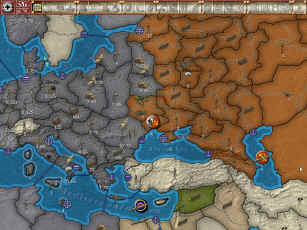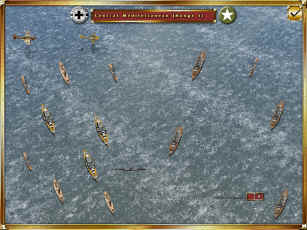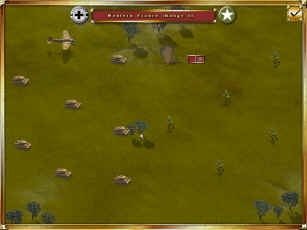|
|
||||||||
THE GLOBAL GAME THE SECOND WORLD WAR ON A GLOBAL SCALE, IN GARY GRIGSBY'S WORLD AT WAR COMPUTER GAME
Gary Grigsby was one of the true pioneers of computer wargame design during its full flowering in the nineteen nineties. Fortunately for us, he remains active, even as the publishers of that time have all either gone out of business or been acquired by Ubi Soft. His latest releaseis Gary Grigsby's World at War, published by Matrix Games (and not to be confused with GMT's similarly-titled A World at War boardgame). Actually,
Gary Grigsby's World at War should not be confused with any other game.
It embodies a distinctive melding of a simple foundation, some sophisticated
systems, and the flexibility for World War II to take a multitude of possible
courses. All of this takes place on a truly global scale that includes
all theaters, all continents, and every ocean. ALL THAT IS SIMPLE...Gary Gribsby's World at War follows in the path of the hugely popular Axis & Allies series of board and computer wargames. Like them, it uses area movement and combat, with a unit scale so abstracted that they do not closely match an identifiable order of battle. The only really consistent element of the scale is the time per turn, which is seasonal. Even there the game takes a liberty with the historical conflict by beginning no early than spring 1940, taking it for granted that Germany enjoyed the very same quick, decisive victory that it accomplished in September 1939. In Asia, Japan is fully immersed in its "China Incident," and the embarrassment of Khalkin Gol is over. The Soviet Union is in the midst of rebuilding its forces after Stalin's destructive purges, and the United States is just emerging from its blissful sleep. There is another area of simplification: The amalgamation of two of the most important combatants on each side. For operational purposes, German and Italian forces are all German in name, emblem and function. On the Allied side, the British Empire and the United States are the collective "Western Allies." In their case though, the player has the option of giving the British and Americans each their own national symbol. That option is simply that-----symbolic-----as they operate identically and team together with no penalty. The unit types are pretty customary. The ground forces are divided into infantry, armor and artillery, plus flak for shooting at airplanes. The game provides for two types of infantry; the standard variety, and a substandard militia. The latter are not all volkstürm and other human speedbumps, but can also represent smaller formations, such as the US Marine defense battalion at Wake Island, that might owe nothing in quality but everything in numbers. Furthermore, a player might want to construct militia instead of their better comrades as a cost-effective force for second-line roles. Not every zone needs or deserves crack troops to hold it. Militia also provides a simple way of showing that the first-line troops of a country could never rise above the second-line of others. China, for example, might field larger numbers of militia, representing the usual dreck led by corrupt and incompetent offers, while the better troops organized by Hans von Seekt and then Joseph Stillwell, are regular infantry in game terms. On the Axis side, militia are the only foot soldiers who can be raised in Italy, reflecting the deficiencies of Il Duce's legions. Land air forces consist of fighters, tactical air units, and heavy bombers. The last also function as transports for the paratroopers. The game makes one miscue when it comes to fighters, as they can fly only in their own zone or an adjacent one, whether it is over land or sea. This makes a lot of sense in most cases, but in other important ones their short range has historical consequences that are too much even for such an abstract game. The first instance that a player is likely to see is the Battle of Britain. If it occurs in Gary Grigsby's World at War, it will not resemble the real one. Historically, German fighters could fly for a limited time over southern England. In the game, they cannot make the flight across the English Channel at all, as it is in a different zone than the southern counties. The same applies to the Allied bombing campaign over Germany, in the bombers can never benefit from P-51 fighter escort to the heart of the Reich. Ships come in four varieties, plus transports. Heavy fleets are the main arbiters of sea control, particularly at first, portraying fleets built around battleships and battlecruisers. Aircraft carriers are rather weak in themselves, but with a carrier airwing, raised separately, they are the trump cards of the high seas. Light fleets are the running mates of both, and are the natural enemies of the final naval type: Submarines. The area-based approach to movement and combat makes for a simpler game than one based on hexagons. Yet there is a cost; the different sizes of the areas mean that the process of seizing a large tract of territory can be no more difficult than taking the smaller one next door. For example, even major powers can have as few as two areas, which is the case for the United Kingdom, making them easier to conquer than they should be. Even the United States has just six from sea to shining sea, so that in the unlikely event of an Axis invasion it not be any more difficult to seize everything from California to the Great Plains than it would be to take one Chinese province. A similar but less extreme situation exists in India, a much more likely target of an Axis offensive. Gary Grigsby's World at War handles combat as a match up between units occupying, or trying to occupy, the same area, depicted in animations. Air units have a role over land or sea, and surface naval units have the option of bombarding in support of coastal land battles. Movement is a
straightforward process. Land and air units tend to have limited
movement rates, one or two zones, which can be extended through strategic
movement over railroads, or sea transport. A unit can initiate one
attack per turn, but there is no separation between movement and combat
phases. In consequence, there is a lot of flexibility in sequencing the
two to maximum effect.
...AND THAT WHICH IS COMPLEX
Despite its essentially simple mechanical
vision of World War II, Gary Grigsby's World at War does not play like
a simple game. From a strategic point of view, this is not a game in which a player can move his units one zone at a time, then fight. It is deceptively fluid, with victory often depending on one's ability to do things in the proper sequence. The Fall of France is a good example. It is impossible for the German to affect the country's collapse in a truly historical manner, through simultaneous attacks on the Low Countries and through the Ardennes. Neither the system nor the map will allow it. Instead, a German player must do what the artificial intelligence does when it controls his side. That is, launch an infantry-heavy offensive into the Netherlands to conquer it quickly (for the sake of clarity, the Netherlands area also includes Belgium and Luxembourg). Then with the direct route to northern France and Paris under his control, the German can send the bulk of his panzers through the Netherlands for a decisive battle for France. It is an ahistorical strategy, resembling the World War I Schlieffen Plan, and pre-Second World War Allied expectations for that matter, than what actually occurred in 1940. Yet it is the way to go about the German offensive in the West and make it work in the game. This is just the most salient example of a phenomenon that occurs throughout Gary Grigsby's World at War. Every player in all theaters faces something similar in that overall success hinges upon a leapfrog effect. Sometimes it is a matter of asserting control of one area to make attacking a further one practical, similar to Case Yellow or, on a bigger scale, Operation Barbarossa. It can also involve a phased effort. In many instances, a player will use airpower and perhaps ships to soften up the defenders in a zone, then send in a force of groundpounders to finish them off. Additionally, there are going to be very few times in which any player is going to have all the assets he wants, where he wants them, and when. As a result, there will be a great deal of shuffling units around the map. A surplus of forces would eliminate this and lead to a simpler strategic environment, but a surplus seldom happens. As with most modern wargames, board or computer, there is a need to match the right forces against the enemies, qualitatively as well as quantitatively. It is not just a matter of overwhelming the enemy with raw numbers; one has to use the right types. One of the most important and readily apparent examples lies in anti-submarine warfare. Not every naval unit can even attack a submarine; light fleets are the only ones that can do so directly. All the others are targets more than anything else, and light fleets too have much to fear from subs. Aircraft are even better for attacking submarines, especially as even today torpedoes have not learned how to hit airplanes. They have the extra benefit of being able to fly to the target from a great distance, with a corresponding increase in flexibility, both for themselves and for their aircraft carriers if they are carrier-borne. Most gamers would expect a grand strategic game on World War II to include production, and Gary Grigsby's World at War fits that pattern. As it turns out, there is absolutely nothing simplistic about unit production in this game, and the economic model is surprisingly sophisticated, eschewing generic production points in favor of interrelated elements of population, resources and industry. Production is not just about putting more units on the map either. There is also research and development of new weapons to make those units stronger and more survivable. New players are likely to feel a little overwhelmed by the production system, and even not up to the job. The game addresses that well by giving the player the option to leave his war economy to the computer, allowing him to concentrate entirely on strategy. This is something to be recommended until a gamer gets used to playing Gary Grigsby's World at War. That goes for grizzled old grognards and not just the novices. THE PRESENTATIONGary Grigsby's World at War is designed to appeal to board wargame veterans, something confirmed by the map. Its resemblance to the look and feel of board wargames goes so far that it includes the folds and ridges of an unmounted paper map. The unit icons though are a different story. They are more like little plastic miniatures than the counters that boardgamers know and love, minus the bases common to games that borrow from miniatures norms.Moving units and initiating combat is easy and intuitive. The production system, and research, are less so. It is not just because these are the most complex, but because their interface is not as as clear as the one for actual military operations. Because of the complexity of these systems and special needs for reference even after learning the game, Gary Grigsby's World at War has a need for effective documentation that exceeds many other games. Fortunately the manual delivers. It is equally good for reference as it is for learning the game in the first place. The need for frequent reference underlines the game's most important incongruity. On one hand, Gary Grigsby's World at War is an exercise in simplicity, a Big Picture, area-oriented look at the greatest war in history. It is a vision in which easy mechanics and an essential intuitiveness permit the player's attention to go straight to grand strategy, without a heavy systemic burden. The game's approach to production and research is essentially a lot more complex. There is nothing wrong with this, and in fact it is a strength. It adds an element of design sophistication to an otherwise introductory-level game, and can further enable Gary Grigsby's World at War to function as a transition to more complicated turn-based historical computer games. There is nothing wrong with that. However, in lieu of easier economic mechanics, it should have adopted an easier approach to these sophisticated systems. That calls for improved, more intuitive interfaces, and possibly a slight reduction in complexity. Ultimately though, these are rather minor concerns. In large part that is because the game manual does such a good job of backstopping the game itself. CONCLUSIONSGary Grigsby's World at War is a hard game not to like. Usually, my own tastes in grand strategy titles runs toward the more sophisticated board wargames, not those calculated to be simple or introductory. Yet this one, and a computer game to boot, has an undeniable appeal. True, the mixed package of simple operational mechanics and sophisticated economics can be problematic in some ways, but not so much that it scuttles the game. The problems are really more minor ones of execution than major conceptual ones.In the never-ending conflict between games and simulations, this one is more of a game overall. There are some phenomena that do not overly resemble historical outcomes, and when they do get closer, it is a fairly rare event. In the Pacific, when the computer-controlled Japanese attack Pearl Harbor to open hostilities against the Western Allies, they are unlikely to achieve anything close to what they did on the Day of Infamy. However, in their first offensive into the South Pacific, they are nearly certain to overachieve, taking all of New Guinea without much trouble and even invading northern Australia. Whether they can hold on to their Australian conquest is a different story, but the ease with which they get there is most ahistorical. There is another striking departure from reality with the Imperial Japanese Navy. Historically, Japan's submarines operated in a role decidedly subordinated to the surface fleet, scouting for it and doing its best work in combat against American naval vessels. In the game, Japanese subs tend to adopt a strategy of unrestricted submarine warfare against Western Allied transports, much closer to German and American strategy than the Japanese. Of the nations at war, the Germans are the most fun to play, at least in my opinion. They start World War II with the initiative, have both strong forces and a lot of potential, and all of Europe stands as potential prey. I find the Western Allies to be the most challenging. They have some major advantages, including the production capacities of the American "Arsenal of Democracy." The challenge is due to the fact that they are the only power with truly global concerns, vulnerabilities and opportunities. The Soviet Union also has a presence in both Europe and East Asia, but the latter is limited, and in most games it is at peace with Japan most of the time. By contrast, the United States and Britain have a lot to lose and a lot to gain everywhere. Theirs is truly a two-ocean war, and a multi-continental one, with production in every hemisphere. In addition, when France is in the game, it is run by the same player who has the United States and British Empire under his control. Add to it the growing production and military forces of the United States, and the Western Allied player has a lot on his plate. Gary Grigsby's World at War can be described as a fun game. Not a deep and involved simulation, and nothing that models combat in a sophisticated manner, but a fun game. That should not be interpreted as an indictment. Instead, being a fun game is something to be praised.
|




